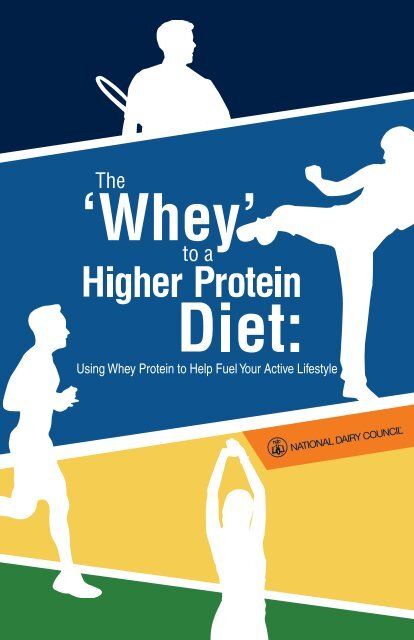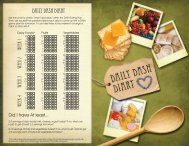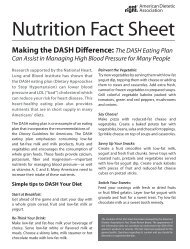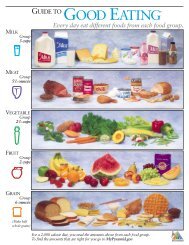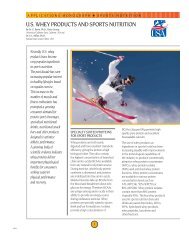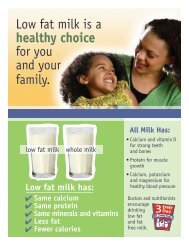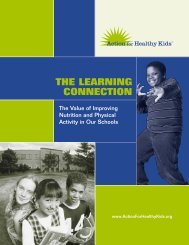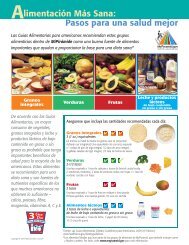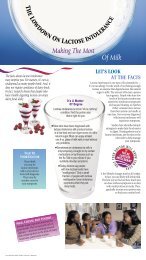Using Whey Protein to Help Fuel Your Active Lifestyle
Using Whey Protein to Help Fuel Your Active Lifestyle
Using Whey Protein to Help Fuel Your Active Lifestyle
You also want an ePaper? Increase the reach of your titles
YUMPU automatically turns print PDFs into web optimized ePapers that Google loves.
<strong>Using</strong> <strong>Whey</strong> <strong>Protein</strong> <strong>to</strong> <strong>Help</strong> <strong>Fuel</strong> <strong>Your</strong> <strong>Active</strong> <strong>Lifestyle</strong>
The Power of
The Power of<br />
<strong>Protein</strong> is an essential nutrient your body<br />
needs every day. The amino acids that<br />
make up protein are often referred <strong>to</strong> as<br />
the “building blocks of life” because they<br />
serve so many important functions in<br />
the body. Beyond its well-known role in<br />
building and repairing lean muscle, protein<br />
controls many metabolic processes in the<br />
body. <strong>Protein</strong> also helps repair body cells<br />
and it helps build and maintain bones.<br />
How is whey protein made?<br />
<strong>Whey</strong> is one of two major proteins found in cow’s<br />
milk. <strong>Whey</strong> protein is produced during the process of<br />
making cheese, which begins when special enzymes<br />
are added <strong>to</strong> milk causing it <strong>to</strong> separate. The curds are<br />
used <strong>to</strong> make cheese, leaving behind whey protein in<br />
the liquid portion. This liquid whey is then pasteurized<br />
and dried in<strong>to</strong> a powder for various uses.<br />
Michael Saunders, PhD, Associate Professor and Direc<strong>to</strong>r of the<br />
Human Performance Labora<strong>to</strong>ry, James Madison University<br />
1
The Power of<br />
The Power of <strong>Protein</strong><br />
Including enough protein, like high-quality<br />
whey protein, in your diet may help you:<br />
• Get more out of your exercise routine by speeding<br />
the rebuilding of muscle after working out. 1-5<br />
• Improve the quality of your weight loss by helping<br />
maintain muscle and/or increase body fat loss, when<br />
following a healthy, reduced-calorie diet. 6-11<br />
• Experience greater satiety, or a feeling of fullness,<br />
which can help curb snacking and over-eating. 12,13<br />
In a joint position statement, “Nutrition and Athletic<br />
Performance,” the American College of Sports Medicine<br />
(ACSM), the American Dietetic Association (ADA), and<br />
the Dietitians of Canada (DC) state that “physical activity,<br />
athletic performance, and recovery from exercise are<br />
enhanced by optimal nutrition.” 14 <strong>Using</strong> the latest scientific<br />
research, the position statement outlines specific nutrition<br />
recommendations, including daily protein intake, for optimal<br />
health and exercise performance. Experts agree that athletes<br />
and individuals who exercise regularly may benefit from<br />
higher protein intakes beyond the minimum requirements<br />
outlined by the Recommended Dietary Allowance (RDA). 14<br />
This booklet is designed <strong>to</strong> help you learn how you<br />
can reach this optimal level of protein in your diet.<br />
2
How does whey protein compare <strong>to</strong><br />
other protein sources, including soy protein?<br />
<strong>Whey</strong> protein is a high quality, nutritionally complete<br />
protein that is rapidly digested and absorbed. Compared<br />
<strong>to</strong> many other proteins, on a gram-<strong>to</strong>-gram basis, whey<br />
protein delivers more branched-chain amino acids,<br />
including leucine, which is important for muscular health.<br />
Stuart Phillips, PhD, Professor, McMaster University<br />
Choose <strong>Protein</strong> Wisely<br />
Many foods contain protein, but the amount and quality<br />
of this protein varies. High-quality protein sources include<br />
meat, fish, poultry, eggs, milk, cheese, yogurt, and whey<br />
protein. These foods supply the complete range of essential<br />
amino acids the body needs <strong>to</strong> build and maintain muscle<br />
and <strong>to</strong> function properly. For this reason, protein found in<br />
animal-based foods is referred <strong>to</strong> as “complete” protein.<br />
<strong>Protein</strong> found in most plant foods, including legumes (beans<br />
and peas), seeds, nuts, vegetables, and grain products,<br />
lacks some of the essential amino acids needed daily<br />
and is therefore considered an “incomplete” protein.<br />
How Much <strong>Protein</strong>?<br />
You can estimate your recommended daily protein intake<br />
using your body weight. Most people need at least<br />
0.4 grams of protein for every pound of body weight<br />
<strong>to</strong> meet basic protein requirements. 15 If you regularly<br />
engage in endurance exercise or strength training,<br />
you may benefit from up <strong>to</strong> twice this amount. 14<br />
Emerging research shows older Americans may be<br />
able <strong>to</strong> reduce the age-related decline of muscle<br />
mass by engaging in resistance training and<br />
16, 17<br />
consuming higher than the RDA for protein.<br />
3
The Power of<br />
Use the following chart <strong>to</strong> find out how much protein is<br />
recommended <strong>to</strong> help you achieve optimal exercise and<br />
health benefits. Calculate your recommended protein intake<br />
based on the type of exercise you do most often.<br />
If you are:<br />
A recreational exerciser 18<br />
An endurance athlete 14<br />
A strength training athlete 14<br />
An athlete restricting calories 18<br />
Multiply your body<br />
weight (in pounds) by:<br />
0.5-0.7 g/lb<br />
0.5-0.8 g/lb<br />
0.5-0.8 g/lb<br />
0.8-0.9 g/lb<br />
Calculate your recommended daily protein<br />
intake based on your exercise routine:<br />
x =<br />
Weight (lbs)<br />
Recommended grams<br />
of protein per pound<br />
Grams of protein<br />
per day<br />
Should I be concerned about getting <strong>to</strong>o much protein?<br />
The Institute of Medicine recommends that 10 <strong>to</strong> 35 percent of the <strong>to</strong>tal calories<br />
we consume each day should come from protein. 15 Although most people<br />
meet minimum protein requirements at the low end of this recommended<br />
range, many more would benefit from a moderately higher protein intake.<br />
<strong>Active</strong> individuals and older adults in particular should be encouraged <strong>to</strong> follow<br />
the MyPyramid recommendations (20-25 percent of calories from protein)<br />
and include a moderate amount of high-quality protein with each meal.<br />
Douglas Paddon-Jones, PhD, Associate Professor, The University of Texas Medical Branch<br />
4
Can I get enough high-quality protein by eating<br />
more meat, chicken, fish, and dairy foods?<br />
Healthy diets should regularly include high-quality, lower fat sources<br />
of protein, including low-fat and fat-free dairy foods, lean meats,<br />
chicken, fish, and eggs. To find out how many servings of these foods<br />
you need each day based on your age, gender, and activity level, check<br />
out www.MyPyramid.gov. Depending on your typical exercise routine,<br />
however, you may benefit from additional protein. Eating additional<br />
servings of these foods or consuming whey protein and staying within<br />
daily calorie allotments are both options. <strong>Whey</strong> protein offers an<br />
easy way <strong>to</strong> obtain additional protein without adding excess fat.<br />
Dan Benardot, PhD, Professor of Nutrition, Professor of<br />
Kinesiology & Health, Georgia State University<br />
Getting Enough Calories <strong>to</strong> Meet <strong>Your</strong><br />
Energy Needs: An Important Fac<strong>to</strong>r in<br />
<strong>Help</strong>ing You Achieve <strong>Your</strong> Fitness Goals<br />
To help ensure that protein in your diet is being<br />
used <strong>to</strong> repair and build muscle, it’s important that<br />
your diet supplies enough calories <strong>to</strong> give you the<br />
energy needed <strong>to</strong> fuel exercise. If your calories are<br />
<strong>to</strong>o low, your body may burn protein as a source<br />
of energy instead of allowing protein <strong>to</strong> serve its<br />
primary role as the building blocks for your body’s<br />
muscles, cells, and organs. To get a quick estimate<br />
of your calorie needs, go <strong>to</strong> www.MyPyramid.<br />
gov. Click on “MyPyramid Menu Planner” and<br />
enter your age, gender, weight, height, and<br />
activity level. You’ll also get a recommended daily<br />
meal pattern for your calorie needs. Or consider<br />
consulting a registered dietitian (RD) specializing<br />
in sports nutrition for a more thorough assessment<br />
of your daily calorie and protein needs.<br />
To compare your recommended daily protein intake <strong>to</strong><br />
the amount of protein you’re currently eating, go <strong>to</strong><br />
www.nationaldairycouncil.org/wheyprotein and click on the<br />
downloadable worksheet, Assessing <strong>Your</strong> Daily <strong>Protein</strong> Intake.<br />
5
The Power of<br />
Why <strong>Whey</strong> <strong>Protein</strong>?<br />
<strong>Whey</strong> protein is a high-quality protein found naturally in dairy<br />
foods. As a complete protein, whey protein provides the amino<br />
acids you need <strong>to</strong> help maximize the benefits of your training<br />
program. 1,19-23 <strong>Whey</strong> protein is one of the best sources of the<br />
amino acid, leucine, which is a type of branched-chain amino<br />
acid (BCAA). Most amino acids are first metabolized in the<br />
liver and then the muscle tissue, but BCAAs, like leucine,<br />
bypass the liver so they can be metabolized directly by<br />
muscle tissue. These amino acids play a key role in promoting<br />
muscle growth. Research has shown that leucine is unique<br />
and acts as a nutrient signal <strong>to</strong> “turn-on” or initiate protein<br />
synthesis in muscle. As a result, researchers have suggested<br />
that individuals who exercise regularly may benefit from diets<br />
higher in leucine <strong>to</strong> help speed the rebuilding of muscle after<br />
working out. 24,25 One way <strong>to</strong> do this is <strong>to</strong> include protein that<br />
is high in leucine, such as whey protein, in your daily diet.<br />
What is hydrolyzed whey protein?<br />
When whey protein is hydrolyzed, the protein chains are<br />
broken down in<strong>to</strong> smaller chains of amino acids called<br />
"peptides." Hydrolyzed whey protein is still a high-quality<br />
protein. It is most commonly used in infant formulas,<br />
medical protein supplements, and some sports drinks.<br />
Nancy Rodriguez, PhD, RD, CSSD, FACSM, Professor,<br />
Nutritional Sciences, University of Connecticut<br />
6
What is the difference between whey protein<br />
concentrate and whey protein isolate?<br />
Both types of whey protein are manufactured by drying pasteurized liquid<br />
whey. The main difference is that whey protein isolate contains a higher<br />
concentration of protein per gram because other ingredients, including lac<strong>to</strong>se,<br />
fat, and some vitamins and minerals, are removed. Both offer health benefits<br />
and are used in various foods and powders that provide whey protein.<br />
David Baer, PhD, Research Physiologist, USDA, ARS Beltsville Human Nutrition Research Center<br />
How <strong>to</strong> Add <strong>Whey</strong> <strong>Protein</strong><br />
Research shows that paying attention <strong>to</strong> when and how much<br />
whey protein you consume can enhance your exercise results.<br />
Eating high-quality protein, like whey protein, close <strong>to</strong> your<br />
workout, either before or after you exercise, may provide<br />
optimal benefits. 4, 26,27 As little as 10 grams of whey protein<br />
in a carbohydrate beverage consumed after exercise has<br />
been shown <strong>to</strong> stimulate the rebuilding of muscle. 19 <strong>Whey</strong><br />
protein is easy <strong>to</strong> digest and provides rapid “nourishment” for<br />
your muscles. It also offers an easy way <strong>to</strong> reach your daily<br />
protein goal without adding excess carbohydrates and fat.<br />
Where <strong>to</strong> Find <strong>Whey</strong> <strong>Protein</strong><br />
<strong>Whey</strong> protein can be found in powders, drink mixes, energy<br />
bars, yogurt, and other foods. To find out if a product contains<br />
whey protein, check the ingredient list. Products with whey<br />
protein as a primary source of protein will list "whey protein<br />
isolate," "whey protein concentrate," or "hydrolyzed whey<br />
protein" near the beginning of the ingredient list. However, when<br />
referring <strong>to</strong> the Nutrition Facts panel on the label, the grams<br />
of protein will include all protein sources, not only whey.<br />
INGREDIENTS: PROTEIN BLEND [{WHEY PROTEIN CONCENTRATE, WHEY PROTEIN<br />
ISOLATE, HYDROLYZED WHEY PROTEIN}, SOY PROTEIN ISOLATE], MILK CHOCOLATE<br />
FLAVORED COATING (SUGAR, PALM KERNEL OIL, NONFAT DRY MILK SOLIDS, COCOA<br />
POWDER, SOY LECITHIN, SALT, NATURAL FLAVOR), INULIN (CHICORY EXTRACT),<br />
VEGETABLE GLYCERIN, PEANUTS, CARAMEL (CORN SYRUP, SUGAR, NONFAT MILK,<br />
FRACTIONATED PALM KERNEL OIL, CREAM, MILK PROTEIN, NATURAL FLAVOR)…<br />
Sample ingredient list<br />
7
The Power of<br />
Examples of Food Sources<br />
Approximate<br />
whey protein* (g)<br />
<strong>Whey</strong> protein powder, 1 scoop 16-24<br />
<strong>Protein</strong> bars 15-30<br />
“<strong>Protein</strong> water” drinks and mixes 5-20<br />
Sports drinks and mixes with 6-30<br />
whey protein<br />
Instant oatmeal with whey protein 5-7<br />
(“weight control” variety)<br />
Everyday Ways <strong>to</strong> Enjoy <strong>Whey</strong> <strong>Protein</strong><br />
Try the following tips and recipes on pages 10–16 for<br />
adding whey protein powder <strong>to</strong> everyday foods you enjoy.<br />
<strong>Whey</strong> protein powder is available flavored or unflavored.<br />
• Add ½ <strong>to</strong> 1 scoop of whey protein powder <strong>to</strong>:<br />
· Any milk-based beverage or food, such as milk,<br />
yogurt, pudding, custard, cottage cheese, oatmeal,<br />
milkshakes, smoothies, or cocoa. Use a vanillaor<br />
chocolate-flavored powder <strong>to</strong> boost flavor.<br />
• Add 2 or more scoops of whey protein powder <strong>to</strong> foods with<br />
multiple servings (estimate ½ <strong>to</strong> 1 scoop per serving), such as:<br />
· Mixes for muffins, pancakes, waffles,<br />
quick bread, and cookies.<br />
*Amounts vary by<br />
product and serving size.<br />
· Soups and casseroles, chili, mashed pota<strong>to</strong>es,<br />
pasta or rice side dishes, scrambled eggs, meatloaf,<br />
hamburger patties, gravies, and sauces.<br />
8
smoothie recipes<br />
Pomegranate Berry Blast Smoothie<br />
Makes 1 serving<br />
6 oz low-fat vanilla yogurt<br />
(or any fruit flavor)<br />
½ cup pomegranate<br />
juice, unsweetened<br />
½ cup berries (strawberries,<br />
blueberries, raspberries), fresh<br />
or frozen, unsweetened<br />
1 scoop whey protein powder,<br />
unflavored or vanilla-flavor<br />
Crushed ice (optional)<br />
Combine in a blender until smooth.<br />
NUTRITION INFORMATION PER<br />
SERVING: 390 calories, 27 g protein<br />
(including 21 g whey protein),<br />
62 g carbohydrate, 2 g fiber, 4 g fat,<br />
2 g saturated fat, 250 mg sodium<br />
Also contains: vitamin A,<br />
vitamin C, vitamin D, calcium,<br />
phosphorus, potassium<br />
Variations:<br />
• Use fat-free yogurt <strong>to</strong><br />
save 70 calories<br />
• For extra protein and flavor, add 2<br />
tablespoons sliced almonds (add<br />
70 calories, 6 g fat, 2 g protein)<br />
If I’m sensitive <strong>to</strong> lac<strong>to</strong>se, should I avoid whey protein?<br />
If you are lac<strong>to</strong>se in<strong>to</strong>lerant, or sensitive <strong>to</strong> lac<strong>to</strong>se, the natural<br />
sugar found in milk products, you may be able <strong>to</strong> <strong>to</strong>lerate<br />
whey protein isolate, which contains very little lac<strong>to</strong>se. The<br />
amount of lac<strong>to</strong>se in whey protein concentrate is higher.<br />
As always, it is important <strong>to</strong> contact the manufacturer as<br />
lac<strong>to</strong>se content can vary from product <strong>to</strong> product.<br />
Chris<strong>to</strong>pher Mohr, PhD, RD, CSSD, Owner, Mohr Results, Inc.<br />
10
smoothie recipes<br />
Choco-Banana Power Smoothie<br />
Makes 1 serving<br />
1 cup fat-free milk<br />
1 small banana, fresh or frozen<br />
1 scoop whey protein<br />
powder, chocolate-flavor<br />
Crushed ice (optional)<br />
Combine in a blender until smooth.<br />
NUTRITION INFORMATION PER<br />
SERVING: 300 calories, 29 g protein<br />
(including 20 g whey protein), 40 g<br />
carbohydrate, 4 g fiber, 3 g fat,<br />
1.5 g saturated fat, 190 mg sodium<br />
Also contains: vitamin A, vitamin<br />
B6, vitamin B12, vitamin C, vitamin<br />
D, riboflavin, calcium, magnesium,<br />
phosphorus, potassium<br />
Variations:<br />
For extra protein and flavor, add 1 tablespoon peanut<br />
butter (add 95 calories, 8 g fat, 4 g protein)<br />
Citrus Fizz<br />
Makes 1 serving<br />
12 oz diet soft drink, lemonlime<br />
or citrus flavor<br />
½ scoop whey protein<br />
powder, unflavored<br />
½ packet (approx. ½ tsp) sugarfree<br />
lemonade or citrus drink mix<br />
Combine with crushed ice.<br />
NUTRITION INFORMATION<br />
PER SERVING: 70 calories,<br />
11 g protein (whey protein),<br />
1 g carbohydrate, 0 g fiber, 1 g fat,<br />
0.5 g saturated fat, 80 mg sodium<br />
Does whey protein have a<br />
gritty or unpleasant taste like<br />
some other protein powders?<br />
<strong>Whey</strong> protein has a clean,<br />
neutral flavor. When used in food<br />
manufacturing, it adds little or<br />
no taste. <strong>Whey</strong> protein dissolves<br />
easily in liquids and does not<br />
have a gritty mouth feel.<br />
Leslie Bonci, MPH, RD, LDN, CSSD,<br />
Direc<strong>to</strong>r of Sports Nutrition, University<br />
of Pittsburgh Medical Center 11
smoothie recipes<br />
Mango-Pineapple Slushie<br />
Makes 1 serving<br />
½ cup fresh or frozen mango<br />
½ cup pineapple, canned<br />
in juice, drained<br />
¼ cup pineapple juice (drained<br />
from canned pineapple)<br />
1 scoop whey protein powder,<br />
unflavored or vanilla-flavor<br />
Crushed ice<br />
Combine in a blender until smooth.<br />
NUTRITION INFORMATION PER SERVING:<br />
280 calories, 22 g protein (including 21 g<br />
whey protein), 45 g carbohydrate, 3 g fiber,<br />
2.5 g fat, 1 g saturated fat, 160 mg sodium<br />
Also contains: vitamin A, vitamin<br />
C, calcium, potassium<br />
Cappuccino Cooler<br />
Makes 1 serving<br />
1 cup black coffee,<br />
room temperature<br />
¼ cup fat-free half & half<br />
1 scoop whey protein powder,<br />
unflavored or vanilla-flavor<br />
1 packet low-calorie<br />
sweetener (optional)<br />
Crushed ice<br />
Combine in a blender until smooth,<br />
or mix well in a glass or shaker cup.<br />
NUTRITION INFORMATION PER<br />
SERVING: 150 calories, 23 g protein<br />
(including 21 g whey protein), 7 g<br />
carbohydrate, 0 g fiber, 3 g fat,<br />
1.5 g saturated fat, 250 mg sodium<br />
Also contains: calcium<br />
12
‘<strong>Whey</strong>-<strong>to</strong>-go’ Recipes<br />
for people on the go<br />
Revved Up Pumpkin-Cranberry Muffins<br />
Makes 16 muffins<br />
1<br />
⁄3 cup vegetable oil<br />
¾ cup brown sugar, packed<br />
¼ cup fat-free milk<br />
¾ cup whey protein powder, unflavored<br />
or vanilla-flavor (about 3 scoops)<br />
2 large eggs<br />
1 15-oz can pure pumpkin<br />
1 cup flour<br />
1 cup whole wheat flour<br />
2 tsp baking powder<br />
½ tsp baking soda<br />
1 tsp cinnamon<br />
½ tsp ginger<br />
¼ tsp salt<br />
½ cup dried cranberries<br />
Chopped pecans (optional)<br />
1. Preheat the oven <strong>to</strong> 375˚F. Coat a<br />
12-cup muffin pan with vegetable<br />
oil cooking spray or paper liners.<br />
2. In a large bowl, combine the<br />
oil, brown sugar, milk, and<br />
whey protein powder.<br />
3. Add the eggs, mixing well after<br />
each; stir in the pumpkin.<br />
4. Add the flours, baking powder,<br />
baking soda, salt, and spices.<br />
Mix just until combined.<br />
5. Gently fold in the dried<br />
cranberries. Spoon the batter<br />
in<strong>to</strong> prepared muffin pan.<br />
6. Sprinkle the <strong>to</strong>ps with cinnamon<br />
and, if desired, chopped<br />
pecans. Bake until lightly<br />
browned, about 20 minutes.<br />
NUTRITION INFORMATION PER MUFFIN: 180 calories, 7 g protein (including 4 g<br />
whey protein), 27 g carbohydrate, 2 g fiber, 6 g fat, 0.5 g saturated fat, 180 mg sodium<br />
Also contains: vitamin A<br />
Does whey protein contain gluten or wheat protein?<br />
<strong>Whey</strong> protein does not contain any wheat protein or gluten.<br />
However, whey protein bars and beverages often contain added<br />
wheat-based ingredients, so be sure <strong>to</strong> check the ingredient list.<br />
Bob Seebohar, MS, RD, CSSD, CSCS, Sport Dietitian, <strong>Fuel</strong>4mance, LLC<br />
13
‘<strong>Whey</strong>-<strong>to</strong>-go’ Recipes<br />
for people on the go<br />
Energy Booster Bars<br />
Makes 15 bars<br />
1 cup quick-cooking oats<br />
½ cup unsalted sunflower seeds<br />
1 cup whey protein powder, unflavored<br />
or vanilla-flavor (about 4 scoops)<br />
½ cup whole wheat flour<br />
1<br />
⁄3 cup sliced almonds<br />
2 tbsp ground flax seed<br />
½ cup dried blueberries or cherries<br />
2 tbsp vegetable oil<br />
2 large eggs<br />
1<br />
⁄3 cup pure maple syrup<br />
¼ cup mini-chocolate chips<br />
1. Preheat oven <strong>to</strong> 350˚F.<br />
Coat a 9x13-inch pan with<br />
vegetable oil cooking spray.<br />
2. Combine oats, sunflower seeds,<br />
whey protein powder, flour,<br />
almonds, flax seed, and dried<br />
blueberries in a food processor<br />
and pulse until coarsely chopped;<br />
transfer <strong>to</strong> a medium bowl.<br />
For chunky bars, just combine<br />
ingredients in a medium bowl.<br />
3. Whisk <strong>to</strong>gether the oil, syrup,<br />
and eggs and add <strong>to</strong> the<br />
oatmeal mixture. Stir until dry<br />
ingredients are moistened. Add<br />
chocolate chips and stir.<br />
4. Gently press in<strong>to</strong> greased pan;<br />
batter will be sticky. Bake until<br />
lightly browned around the edges,<br />
about 15–20 minutes. Cool and<br />
cut in<strong>to</strong> 15 bars (1½˝ x 4˝).<br />
NUTRITION INFORMATION PER BAR: 190 calories, 10 g protein (including 6 g whey<br />
protein), 21 g carbohydrate, 3 g fiber, 8 g fat, 1.5 g saturated fat, 150 mg sodium<br />
Is whey protein easy <strong>to</strong> digest?<br />
<strong>Whey</strong> protein has a high biological value, which means it<br />
is easy <strong>to</strong> digest and is efficiently used by the body. It is<br />
absorbed quickly and provides important essential amino<br />
acids needed <strong>to</strong> nourish muscles and other body tissues.<br />
Wayne Campbell, PhD, Professor, Department<br />
of Foods & Nutrition, Purdue University<br />
14
‘<strong>Whey</strong>-<strong>to</strong>-go’ Recipes<br />
for people on the go<br />
Mushroom Swiss Meatball Soup<br />
Makes 6 servings,<br />
about 2 cups per serving<br />
1 tbsp vegetable oil<br />
½ cup chopped onion<br />
½ cup chopped celery<br />
8 oz chopped mushrooms, or 8<br />
oz canned mushrooms, drained<br />
1 can cream of mushroom soup,<br />
94% fat-free, reduced sodium<br />
3 cups beef broth<br />
1 cup fat-free milk<br />
½ cup whey protein powder,<br />
unflavored (about 2 scoops)<br />
1 tbsp flour<br />
1 cup shredded Swiss cheese<br />
Beef meatballs (see recipe below)<br />
1. Add oil <strong>to</strong> large pot and<br />
saute onions and celery until<br />
tender, about 5 minutes.<br />
2. Add chopped mushrooms<br />
and cook until softened.<br />
3. Stir in mushroom soup<br />
and beef broth.<br />
4. Whisk <strong>to</strong>gether milk, whey protein<br />
powder, and flour until smooth.<br />
Add <strong>to</strong> soup and simmer gently<br />
until thickened, about 10 minutes.<br />
5. Add meatballs and simmer until<br />
heated through. Remove from heat<br />
and stir in Swiss cheese. Season<br />
with salt and pepper as desired.<br />
Beef Meatballs<br />
Makes about 28 meatballs,<br />
4-5 meatballs per serving<br />
1 pound 90% lean ground beef<br />
½ cup chopped onions<br />
½ cup bread crumbs<br />
½ cup whey protein powder,<br />
unflavored (about 2 scoops)<br />
2 egg whites<br />
½ tsp salt<br />
1. Preheat oven <strong>to</strong> 350˚F. Line a 15˝<br />
x 10˝ pan with foil. Spray lightly<br />
with vegetable oil cooking spray.<br />
2. Combine all ingredients in a bowl.<br />
3. Form gently in<strong>to</strong> 1-inch<br />
meatballs and place on pan.<br />
4. Bake until cooked through,<br />
about 15 minutes.<br />
Time-saving tip: Use frozen beef meatballs.<br />
NUTRITION INFORMATION PER SERVING: 350 calories, 39 g protein (including 14 g<br />
whey protein), 14 g carbohydrate, 1 g fiber, 15 g fat, 7 g saturated fat, 840 mg sodium<br />
Also contains: vitamin B12, niacin, calcium, iron, magnesium, potassium, zinc<br />
15
‘<strong>Whey</strong>-<strong>to</strong>-go’ Recipes<br />
for people on the go<br />
Creamy Caramel Dip for Fruit<br />
Makes 2 cups, about 8 ¼-cup servings<br />
8 oz reduced-fat cream<br />
cheese (Neufchatel)<br />
¾ cup whey protein powder, unflavored<br />
or vanilla-flavor (about 3 scoops)<br />
½ cup plain fat-free yogurt<br />
½ cup brown sugar<br />
2 tsp vanilla<br />
Combine all ingredients in a<br />
medium bowl and beat with an<br />
electric mixer until smooth and<br />
creamy. Serve immediately with<br />
your favorite fruits, or refrigerate.<br />
Variation:<br />
For extra flavor and protein, add<br />
1<br />
⁄3 cup ground almonds (add 20<br />
calories, 2 g fat, 1 gram protein)<br />
NUTRITION INFORMATION PER ¼-CUP SERVING: 170 calories, 12 g protein (including<br />
8 g whey protein), 16 g carbohydrate, 0 g fiber, 7 g fat, 4.5 g saturated fat, 200 mg sodium<br />
Also contains: calcium<br />
Is whey protein a good source of calcium?<br />
<strong>Whey</strong> protein contains calcium, but the amount is fairly low<br />
and varies by product. <strong>Your</strong> best option for meeting your calcium<br />
needs (1,000 milligrams for ages 19-50 years; 1,200 milligrams<br />
for 51+ years) is consuming three servings of low-fat and<br />
fat-free dairy foods each day. Each serving provides about 300<br />
milligrams of calcium; 1 serving equals 1 cup of milk or yogurt,<br />
1 ½ ounces of natural cheese, or 2 ounces of processed cheese.<br />
Susan Kundrat, MS, RD, CSSD, LDN, President,<br />
Nutrition on the Move, Inc.<br />
16
SAMPLE MENU<br />
Sample Meal Plans with <strong>Whey</strong> <strong>Protein</strong><br />
The following examples show how <strong>to</strong> create daily<br />
menus at different calorie levels that meet the<br />
recommended amounts of food from each food<br />
group—and provide ample protein—without<br />
exceeding calorie goals. Remember that your<br />
calorie needs may vary from day <strong>to</strong> day depending<br />
on the intensity and length of your workouts.<br />
17
SAMPLE MENU<br />
1,800 CALORIES<br />
WHEY PROTEIN<br />
(GRAMS)<br />
BREAKFAST:<br />
Whole wheat bagel (2 oz)<br />
Peanut butter (2 tbsp)<br />
Banana (1 small)<br />
Fat-free milk (1 cup)<br />
LUNCH:<br />
Tuna salad pita sandwich<br />
Tuna canned in water (3 oz)<br />
Light mayonnaise (2 tbsp)<br />
<strong>Whey</strong> protein powder (½ scoop)<br />
Lettuce leaf<br />
Pita pocket bread (1)<br />
Baby carrots (½ cup)<br />
Orange juice (1 cup)<br />
10 g<br />
DINNER:<br />
Whole grain pasta (1 cup)<br />
Marinara sauce (½ cup)<br />
Mixed greens (2 cups)<br />
Chopped <strong>to</strong>ma<strong>to</strong>es (¼ cup)<br />
Chopped cucumbers (¼ cup)<br />
Light Italian dressing (2 tbsp)<br />
Fat-free milk (1 cup)<br />
PRE- OR POST-WORKOUT SNACK:<br />
Energy Booster Bar* (1)<br />
Fat-free milk (1 cup) mixed with<br />
chocolate-flavored whey<br />
protein powder (½ scoop)<br />
6 g<br />
10 g<br />
*See recipes on pages 10–16.<br />
18
SAMPLE MENU<br />
2,200 CALORIES<br />
WHEY PROTEIN<br />
(GRAMS)<br />
BREAKFAST:<br />
Egg sandwich<br />
Cooked egg (1)<br />
American cheese (.75 oz slice)<br />
Whole grain English muffin (1)<br />
Grapefruit (½)<br />
Low-fat milk (1 cup)<br />
LUNCH:<br />
Mushroom Swiss Meatball Soup* (2 cups)<br />
Breadstick (2 oz)<br />
Cantaloupe cubes (1 cup)<br />
Revved Up Pumpkin-Cranberry Muffin* (1)<br />
Diet lemonade<br />
14 g<br />
4 g<br />
DINNER:<br />
Baked halibut (3 oz)<br />
Baked sweet pota<strong>to</strong> (1 medium)<br />
Whipped butter (1 tbsp)<br />
Green beans (½ cup)<br />
Cornbread (1 piece, 2 oz)<br />
Baby spinach (3 cups)<br />
Mandarin oranges (½ cup)<br />
Chopped walnuts (½ oz)<br />
Balsamic vinaigrette (3 tbsp)<br />
Low-fat milk (1 cup)<br />
PRE- OR POST-WORKOUT SNACK:<br />
Cappuccino Cooler*<br />
21 g<br />
*See recipes on pages 10–16.<br />
19
SAMPLE MENU<br />
2,600 CALORIES<br />
WHEY PROTEIN<br />
(GRAMS)<br />
BREAKFAST:<br />
“Weight control” instant oatmeal (¾ cup)<br />
<strong>Whey</strong> protein powder (½ scoop)<br />
Fat-free milk (1 cup)<br />
Low-fat fruit yogurt (6 oz)<br />
SNACK:<br />
Strawberries (1 cup)<br />
<strong>Protein</strong> water (2 cups)<br />
Blueberry muffin (1 medium)<br />
5 g<br />
10 g<br />
5 g<br />
20<br />
LUNCH:<br />
Chef’s Salad<br />
Romaine lettuce (3 cups)<br />
Feta cheese crumbles (1 oz)<br />
Turkey breast (1 oz)<br />
Sliced hard-boiled egg (1)<br />
Ranch dressing (3 tbsp)<br />
Crou<strong>to</strong>ns (1 oz)<br />
Whole wheat roll (1)<br />
Flavored water<br />
DINNER:<br />
Beef fajitas<br />
Lean beef sirloin (3 oz)<br />
Vegetable oil (1 tsp)<br />
Whole wheat flour <strong>to</strong>rtillas (2)<br />
Sliced peppers & onions (1 cup)<br />
Sliced avocado (½ cup)<br />
Shredded Monterey jack<br />
cheese (¼ cup)<br />
Spanish rice (1 cup)<br />
Iced tea<br />
PRE- OR POST-WORKOUT SNACK:<br />
Mango-Pineapple Slushie*<br />
*See recipes on pages 10–16.<br />
21 g
SAMPLE MENU<br />
3,000 CALORIES<br />
WHEY PROTEIN<br />
(GRAMS)<br />
BREAKFAST:<br />
Buttermilk pancakes (3)<br />
Light maple syrup (3 tbsp)<br />
Hard-boiled egg (1)<br />
Grapefruit (½)<br />
Low-fat milk (1 cup)<br />
SNACK:<br />
Microwave popcorn, 94% fat free (3 cups)<br />
Choco-Banana Power Smoothie*<br />
LUNCH:<br />
Mushroom Swiss Meatball Soup* (2 cups)<br />
Soft breadsticks (2)<br />
Cantaloupe cubes (1 cup)<br />
Oatmeal raisin cookie (1)<br />
Diet lemonade<br />
20 g<br />
14 g<br />
DINNER:<br />
Broiled pork chop (4 oz)<br />
Mashed pota<strong>to</strong>es (1 cup)<br />
Steamed broccoli (1 cup)<br />
Whole-grain roll (1)<br />
Whipped butter (1 tbsp)<br />
Baby spinach (3 cups)<br />
Chopped mushrooms (½ cup)<br />
Balsamic vinaigrette (3 tbsp)<br />
Low-fat milk (1 cup)<br />
PRE- OR POST-WORKOUT SNACK:<br />
Energy Booster Bar* (1)<br />
Apple (1 medium)<br />
Creamy Caramel Dip* (¼ cup)<br />
6 g<br />
8 g<br />
*See recipes on pages 10–16.<br />
21
References<br />
1 <br />
Tip<strong>to</strong>n KD, Elliott TA, Cree MG, et al. Ingestion of casein and<br />
whey proteins result in muscle anabolism after resistance<br />
exercise. Med Sci Sports Exerc. 2004;36:2073-81.<br />
2 <br />
Tip<strong>to</strong>n KD, Elliot TA, Cree MG, et al. Stimulation of net muscle<br />
protein synthesis by whey protein ingestion before and after<br />
exercise. Am J Physiol Endocrinol Metab. 2007;292:71-76.<br />
3 <br />
Phillips SM, Hartman JW, Wilkinson SB. Dietary protein<br />
<strong>to</strong> support anabolism with resistance exercise in<br />
young men. J Am Coll Nutr. 2005;24:134S-9S.<br />
4 <br />
Tang JE, Phillips SM. Maximizing muscle protein anabolism: the role<br />
of protein quality. Curr Opin Clin Nutr Metab Care. 2009;12:66-71.<br />
5 <br />
Howarth KR, Moreau NA, Phillips SM, Gibala MJ. Co-ingestion<br />
of protein with carbohydrate during recovery from endurance<br />
exercise stimulates skeletal muscle protein synthesis in<br />
humans. J Appl Physiol. 2009;106(4):1394-1402<br />
6 <br />
Layman DK, Boileau RA, Erickson DJ, et al. A reduced ratio of dietary<br />
carbohydrate <strong>to</strong> protein improves body composition and blood lipid<br />
profiles during weight loss in adult women. J Nutr. 2003;133:411-7.<br />
7 <br />
Layman DK, Evans EM, Erickson D, et al. A moderateprotein<br />
diet produces sustained weight loss and longterm<br />
changes in body composition and blood lipids<br />
in obese adults. J Nutr. 2009;139:514-21.<br />
8 <br />
Leidy HJ, Carnell NS, Mattes RD, Campbell WW. Higher protein<br />
intake preserves lean mass and satiety with weight loss in<br />
pre-obese and obese women. Obesity. 2007;15:421-9.<br />
9 <br />
Lasker DA, Evans EM, Layman DK. Moderate carbohydrate,<br />
moderate protein weight loss diet reduces cardiovascular disease<br />
risk compared <strong>to</strong> high carbohydrate, low protein diet in obese<br />
adults: A randomized clinical trial. Nutr Metab (Lond). 2008;5:30.<br />
23
The Power of<br />
References<br />
10 <br />
Krieger JW, Sitren HS, Daniels MJ, Langkamp-Henken B.<br />
Effects of variation in protein and carbohydrate intake on<br />
body mass and composition during energy restriction: a<br />
meta-regression. Am J Clin Nutr. 2006;83:260-74.<br />
11 <br />
Gordon MM, Bopp MJ, Easter L, et al. Effects of dietary<br />
protein on the composition of weight loss in postmenopausal<br />
women. J Nutr Health Aging. 2008;12:505.<br />
12 <br />
Veldhorst M, Smeets A, Soenen S, et al. <strong>Protein</strong>induced<br />
satiety: effects and mechanisms of different<br />
proteins. Physiol Behav. 2008;94:300-307.<br />
13 <br />
Paddon-Jones D, Westman E, Mattes RD, et al. <strong>Protein</strong>, weight<br />
management, and satiety. Am J Clin Nutr. 2008;87(suppl):1558S-61S.<br />
14 <br />
Position of the American Dietetic Association, Dietitians of<br />
Canada, and the American College of Sports Medicine: Nutrition<br />
and Athletic Performance. J Am Diet Assoc. 2009;109:509-27.<br />
15 <br />
Food and Nutrition Board, Institute of Medicine. Dietary<br />
Reference Intakes for Energy, Carbohydrate, Fiber, Fat,<br />
Fatty Acids, Cholesterol, <strong>Protein</strong>, and Amino Acids.<br />
Washing<strong>to</strong>n DC: National Academies Press, 2005.<br />
16<br />
Paddon-Jones D, Short KR, Campbell WW, et al.<br />
Role of dietary protein in the sarcopenia of aging.<br />
Am J Clin Nutr. 2008; 87(suppl): 1562S-1566S<br />
17<br />
Kim JS, Wilson JM and Lee SR. Dietary implications on<br />
mechanisms of sarcopenia: roles of protein, amino acids<br />
and antioxidants. J Nutr Biochem. 2010; 21(1): 1-13.<br />
18 <br />
Clark N. Nancy Clark’s Sports Nutrition Guidebook,<br />
4th ed. Champaign, Ill: Human Kinetics, 2008.<br />
24
References<br />
19 <br />
Tang JE, Manolakos JJ, Kujbida GW, et al. Minimal whey<br />
protein with carbohydrate stimulates muscle protein<br />
synthesis following resistance exercise in trained young<br />
men. Appl Physiol Nutr Metab. 2007;32:1132-8.<br />
20 <br />
Burke DG, Chilibeck PD, Davidson KS, et al. The effect of whey<br />
protein supplementation with and without creatine monohydrate<br />
combined with resistance training on lean tissue mass and muscle<br />
strength. Int J Sport Nutr Exerc Metab. 2001;11:349-64.<br />
21 <br />
Candow DG, Burke NC, Smith-Palmer T, Burke DG. Effect of whey<br />
and soy protein supplementation combined with resistance training<br />
in young adults. Int J Sport Nutr Exerc Metab. 2006;16:233-44.<br />
22 <br />
Cribb PJ, Williams AD, Carey MF, Hayes A. The effect of whey<br />
isolate and resistance training on strength, body composition, and<br />
plasma glutamine. Int J Sport Nutr Exerc Metab. 2006;16:494-509.<br />
23 <br />
Hulmi JJ, Kovanen V, Selänne H, Kraemer WJ, Häkkinen K,<br />
Mero AA. Acute and long-term effects of resistance exercise<br />
with or without protein ingestion on muscle hypertrophy and<br />
gene expression. Amino Acids. 2009;37(2):297-308.<br />
24 <br />
Nor<strong>to</strong>n LE, Layman DK. Leucine regulates translation<br />
initiation of protein synthesis in skeletal muscle<br />
after exercise. J Nutr. 2006;136:533S-7S.<br />
25 <br />
Layman DK. The role of leucine in weight loss and<br />
glucose homeostasis. J Nutr. 2003;133:261S-67S.<br />
26 <br />
Cribb PJ, Hayes A. Effects of supplement timing and<br />
resistance exercise on skeletal muscle hypertrophy.<br />
Med Sci Sports Exerc. 2006;38:1918-25.<br />
27 <br />
Kerksick C, Harvey T, S<strong>to</strong>ut J, et al. International<br />
Society of Sports Nutrition position stand: Nutrient<br />
timing. J Int Soc Sports Nutr. 2008;5:17-29.<br />
25


